Projects that did not take off
Cloud4Y already talked about interesting projects developed in the USSR. Continuing the topic, let us recall what other projects had good prospects, but for a number of reasons they did not receive wide recognition or were put on the cloth at all.
Gas station

During the preparations for the Olympics-80, it was decided to demonstrate to all (and primarily capitalist countries) the modernity of the USSR. And gas stations have become one of the ways to demonstrate the strength and best practices of the country. In Japan, several gas stations were ordered (according to some sources, 5 or 8, but the figure is inaccurate), which radically differed from the usual gas stations.
The first was installed on Brovarsky Avenue in Kiev, between the metro Darnitsa and Levoberezhnaya. By the way, refueling is still working now , although refueling guns are no longer fed from above. The rest of the equipment lay idle for a long time, and either rotted, or was stolen, but the remaining was only enough for another gas station. She was put on the Kharkov highway.
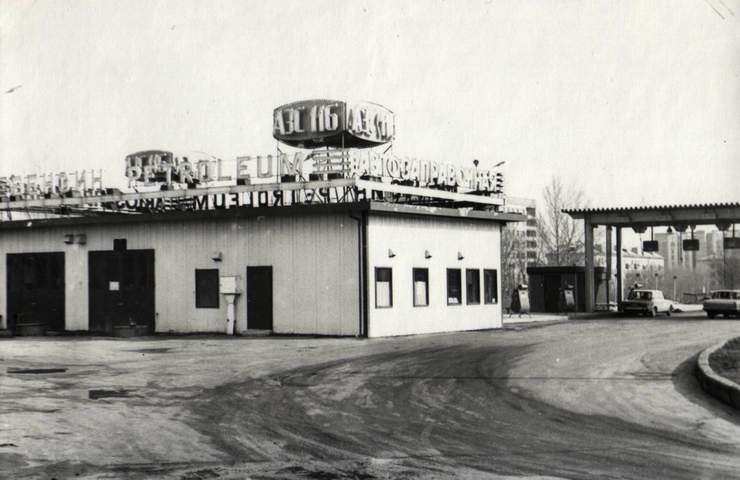
More such gas stations did not. However, there were others. For example, in Kuibyshev (now Samara), at the intersection of Moskovsky Highway and Revolutionary Street, there was a gas station, which also supplied fuel from above.
On the highway of the Black Sea coast in Lower Khobz (near Sochi) there was a gas station-plate. The station was built in 1975 according to the original design, taking into account the nature of the terrain, climatic conditions and is equipped with domestic equipment.

It’s a pity that on this creative ideas for filling out gas stations ended. The country was not up to design, so the appearance of the gas station has not changed much today. Yes, everything has become more modern and convenient, but the essence is the same. And what about the design of gas stations in other countries? Here is a small selection of beautiful gas stations.
Tea set Malevich
No, he is not black. White. The famous artist came up with a service of an unusual geometric shape. Casimir spent his whole life looking for new forms, trying to change the idea of how familiar things might look. And in the case of the service he succeeded.

The creation of the service became possible due to the fact that after the October Revolution, the Imperial Porcelain Factory began to produce porcelain "revolutionary in content, perfect in form and impeccable in technical performance." And he actively involved avant-garde artists in the creation of new collections.
Malevich’s four-piece service is a prime example of the realization of avant-garde ideas in functional objects. Four cups are made in the form of simplified hemispheres with rectangular handles. And the kettle can be described as a triumph of design over functionality and convenience. Its unusual shape will perplex you.
Malevich’s dishes were not convenient, but the idea itself was more important for the artist. The products of the avant-garde did not go into mass production, although the service is still produced at the Imperial Porcelain Factory.
Lunar base "Star"

The first detailed project of the base on the moon. The concept of the lunar town was considered in the 1960s and 70s. It was planned to operate the station on the Moon solely for scientific purposes, although in fact the base also had military potential: it could accommodate missile systems and tracking equipment, inaccessible to terrestrial weapons. The program reached the final stage, but due to a number of problems, scientists had to curtail the project.
According to the project, the first “moon train” with 4 astronauts on board was to land on the moon. With the help of the train, the expedition members would conduct a detailed study of the area and begin to build a temporary lunar base. With the help of heavy rocket launchers, it was planned to deliver 9 modules to the lunar surface. Each module had a specific purpose: laboratory, storage, workshop, galley, dining room, medical center with a gym and three residential premises.
The length of the inhabited modules was 8.6 m, the diameter was 3.3 m; total mass - 18 tons. A shortened block of not more than 4 m in length was delivered to the moon on the spot. And then, thanks to a metal accordion, it stretched to the desired length. The interior was supposed to be filled with inflatable furniture, and residential cells were designed for two people.
Crews for lunar ships were selected, flights were planned for the late 1980s. What went wrong? Boosted rockets. The program was closed on November 24, 1972, when the fourth launch of the "lunar rocket" N-1 ended in an accident. According to analysts, the cause of the explosions was the inability to manage a large number of engines in a coordinated manner. This was the biggest failure of S.P. Queen. In addition, the designers estimated that about 50 billion rubles ($ 80 billion) would be required for lunar expeditions, the construction and settlement of the lunar base. It was too much. The idea of building a lunar base was postponed until later.
OS DEMOS

Around 1982-1983, at the Institute of Atomic Energy. I.V. Kurchatov brought distributions of the UNIX operating system (v6 and v7). Having connected specialists of other organizations to the work, scientists tried to adapt the OS to Soviet conditions: translate into Russian and establish compatibility with domestic equipment. First of all, with the SM-4 and SM-1420 machines. Localization was carried out by the Institute for Advanced Studies of the Minavtoprom.
After combining the teams, the project was called DEMOS (Dialogue Unified Mobile Operating System). It's funny that UNAS could also call it, as if contrasting the fact that UNIX is “with them”. And the Minavtoprom called the MNOS system (Machine Independent Operating System).
The Soviet OS actually combined the two versions of Unix: the 16-bit DEC PDP OS and the system for 32-bit VAX computers. DEMOS worked on both architectures. And when the production of SM 1700, the analogue of VAX 730, began at the plant in Vilnius, then the OS DEMOS was already installed on it.
In 1985, DEMOS 2.0 was released, and in 1988, the developers of the Soviet OS were awarded the Prize of the Council of Ministers of the USSR for Science and Technology. But in the 1990s, the project was closed. It's sad of course. After all, who knows, could our development surpass theenemy product from Microsoft?
Workspace Rodchenko
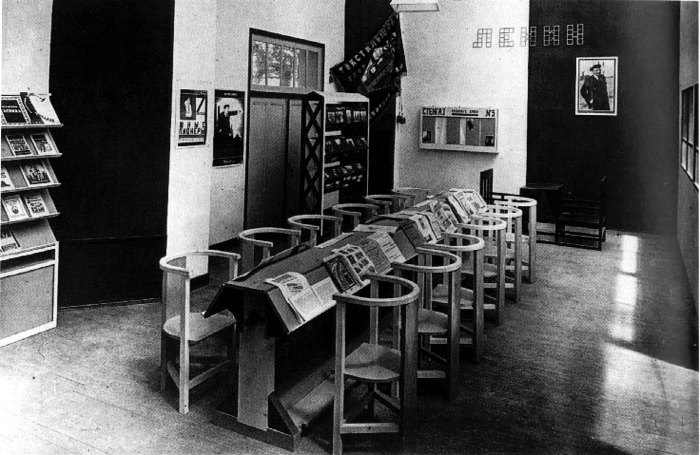
The constructivist interior of Alexander Rodchenko, dubbed the “Work Club”, was exhibited in the USSR Pavilion at the International Exhibition of Decorative Arts in Paris in 1925. This was the first major international exhibition in which the Soviet Union took part. Rodchenko created a multifunctional space that reflects the ideals of a new society looking to the future. It was believed that the interior would become the basic form of work clubs, both in design and planning decisions.
“Work Club” is not just a room decorated in a constructivist style. It was a real philosophy of creating a space in which Soviet workers could exchange opinions, make speeches, engage in self-education, play chess, etc. Following the canons of multifunctionality, the artist created compact objects that could transform into others.
For example, a folding stand could also be a place for lectures, speeches, theatrical evenings, and in order to save space, the chess table was made rotatable so that players could change the color of their figures without leaving their seats. According to Rodchenko, he was guided by the principle, "which makes it possible to deploy an object in his work over a large area, as well as compactly fold it at the end of the work."
Four colors were used in the design - gray, red, black and white. Coloring was given great importance - it emphasized the nature of objects and how to use them.
The project received a silver medal, and after the exhibition it was presented to the Communist Party of France, so it has never been exhibited in Russia. However, in 2008, German experts reconstructed the club for their exhibition “From Plane to Space. Malevich and early modernism, ”and then presented a copy of the Tretyakov Gallery.
Underground boat

A dramatic story full of espionage passions and mysterious explosions. In the 1930s, engineer Alexander Trebelsky (according to other sources - Trebelev) literally raved about the idea of creating a "subterrine" - a vehicle that could move underground like tunnel shields, but at the same time faster, quieter and with greater benefit.
Initially, Trebelevsky tried to create a thermal supercontour - a device that, if necessary, could heat the outer shell of an underground boat and burn through solid soil. But later he abandoned this idea, inventing a design whose working principle was borrowed from an ordinary mole. These animals dig the ground, turning their paws and head, and then push their body with their hind legs. In this case, the earth is pushed into the walls of the resulting hole.
An underground boat was designed in the same way. A powerful drill was located on the nose, in the middle there were screws pushing the rock into the walls of the wells, and behind were four powerful jacks that moved the device forward. When the drill rotated at a speed of 300 rpm, the submarine overcame a distance of 10 m in an hour. It seemed to be a success. It turned out that seemed.
In 1933, Trebelevsky was arrested by the NKVD for meeting with a certain engineer during a trip to Germany and bringing in blueprints from there. It turned out that Trebelevsky borrowed the idea of an underground boat from Horner von Wern and tried to bring it to mind. Drawings settled somewhere in the NKVD. Like the engineer himself.
The iron mole was recalled again in the 60s: Nikita Khrushchev publicly promised "to get the imperialists not only in space but also underground." The advanced minds of the USSR were connected to work on the new boat: Leningrad professor Babaev and even academician Sakharov. The result of painstaking work was a machine with a nuclear reactor, managed by a crew of 5 crew members and capable of transporting a ton of explosives and 15 fighters. They tested the subterrine in the fall of 1964 in the Urals near Mount Grace. The underground boat was called the “Battle Mole”.
The device penetrated the ground at the speed of a pedestrian, walked about 15 km and destroyed the enemy’s conditional underground bunker. The test results surprised the military and scientists. They decided to repeat the experiment, but the battle mole exploded underground, destroying all the people on board and being permanently stuck in the bowels of the Ural mountains. What caused the explosion is not known for certain, because all the materials on this incident are still under the heading "top secret." Most likely, the plant’s nuclear engine exploded. After the emergency, the decision on the further use of the underground boat was postponed, and then completely turned off.
And what interesting, but not “soaring” projects do you remember?
What else is useful to read on the Cloud4Y blog
→ vGPU - use cannot be ignored
→ AI helps study animals in Africa
→ 4 ways to save on backups in the cloud
→ 5 Best Kubernetes Distributions
→ Robots and strawberries: how AI increases field yields
Subscribe to our Telegram channel so as not to miss another article! We write no more than twice a week and only on business.
Gas station

During the preparations for the Olympics-80, it was decided to demonstrate to all (and primarily capitalist countries) the modernity of the USSR. And gas stations have become one of the ways to demonstrate the strength and best practices of the country. In Japan, several gas stations were ordered (according to some sources, 5 or 8, but the figure is inaccurate), which radically differed from the usual gas stations.
The first was installed on Brovarsky Avenue in Kiev, between the metro Darnitsa and Levoberezhnaya. By the way, refueling is still working now , although refueling guns are no longer fed from above. The rest of the equipment lay idle for a long time, and either rotted, or was stolen, but the remaining was only enough for another gas station. She was put on the Kharkov highway.

More such gas stations did not. However, there were others. For example, in Kuibyshev (now Samara), at the intersection of Moskovsky Highway and Revolutionary Street, there was a gas station, which also supplied fuel from above.
On the highway of the Black Sea coast in Lower Khobz (near Sochi) there was a gas station-plate. The station was built in 1975 according to the original design, taking into account the nature of the terrain, climatic conditions and is equipped with domestic equipment.

It’s a pity that on this creative ideas for filling out gas stations ended. The country was not up to design, so the appearance of the gas station has not changed much today. Yes, everything has become more modern and convenient, but the essence is the same. And what about the design of gas stations in other countries? Here is a small selection of beautiful gas stations.
Many photos of gas stations 
Gas station on the Kharkov highway
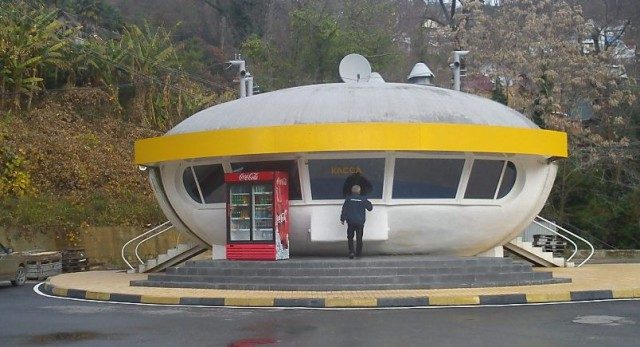
Refueling in Sochi now
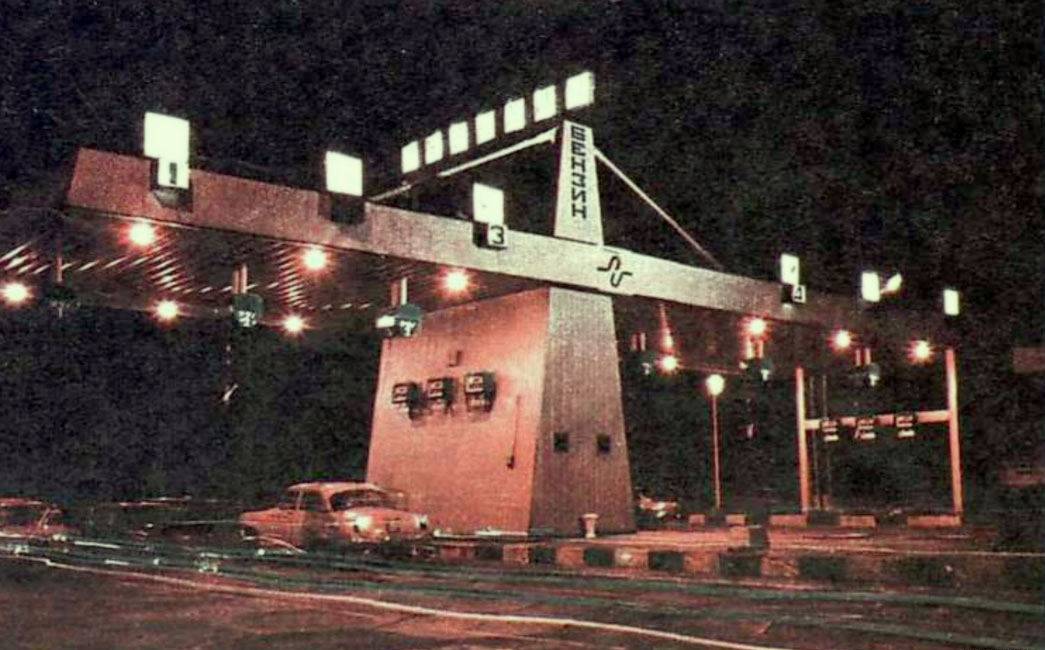
And here is another unusual dressing. Photo dated 1977

The POPS Arcadia Route 66 gas station in Oklahoma (USA) is visible from afar thanks to a giant bottle 20 meters high
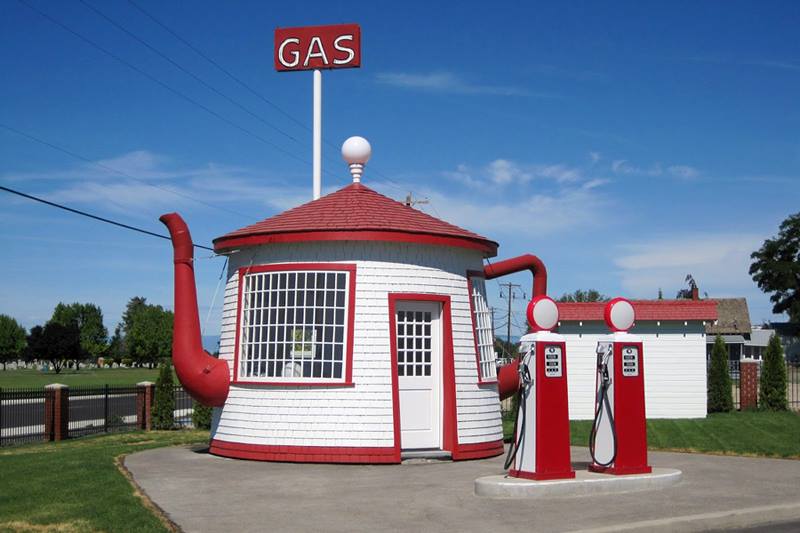
The gas station in the American town of Zilla received this form in honor of the nearby mountain, in the bowels of which oil was extracted. The mountain was called Tipot Dome, which is consonant with the word teapot - that is, a teapot

But such a gas station-hut, as in Canada, we will never build. It hurts, it looks flammable

The gas station from the Slovak town Matushkovo, built in 2011, also looks interesting. Canopy shapes are like flying saucers
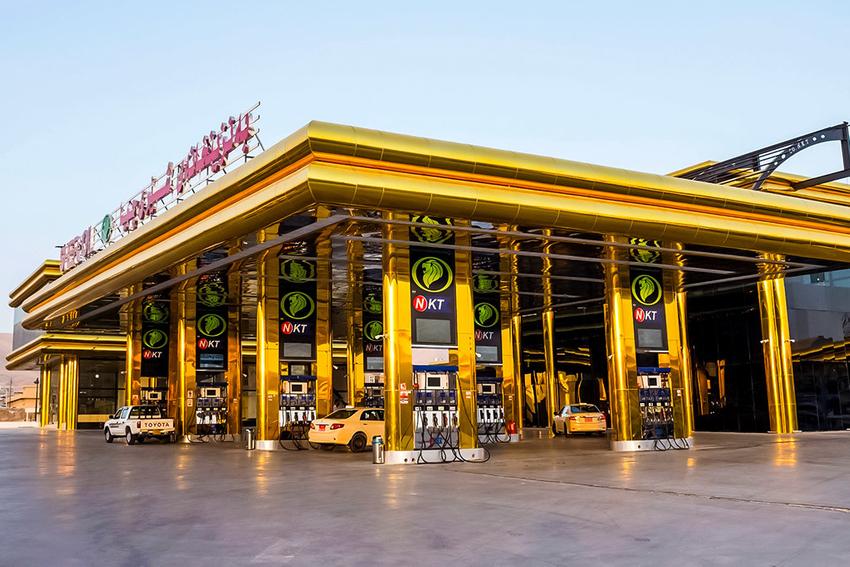
But this “golden dressing” from Iraq will make you feel like king Midas.

Gas station on the Kharkov highway

Refueling in Sochi now

And here is another unusual dressing. Photo dated 1977

The POPS Arcadia Route 66 gas station in Oklahoma (USA) is visible from afar thanks to a giant bottle 20 meters high

The gas station in the American town of Zilla received this form in honor of the nearby mountain, in the bowels of which oil was extracted. The mountain was called Tipot Dome, which is consonant with the word teapot - that is, a teapot

But such a gas station-hut, as in Canada, we will never build. It hurts, it looks flammable

The gas station from the Slovak town Matushkovo, built in 2011, also looks interesting. Canopy shapes are like flying saucers

But this “golden dressing” from Iraq will make you feel like king Midas.
Tea set Malevich
No, he is not black. White. The famous artist came up with a service of an unusual geometric shape. Casimir spent his whole life looking for new forms, trying to change the idea of how familiar things might look. And in the case of the service he succeeded.

The creation of the service became possible due to the fact that after the October Revolution, the Imperial Porcelain Factory began to produce porcelain "revolutionary in content, perfect in form and impeccable in technical performance." And he actively involved avant-garde artists in the creation of new collections.
Malevich’s four-piece service is a prime example of the realization of avant-garde ideas in functional objects. Four cups are made in the form of simplified hemispheres with rectangular handles. And the kettle can be described as a triumph of design over functionality and convenience. Its unusual shape will perplex you.
Malevich’s dishes were not convenient, but the idea itself was more important for the artist. The products of the avant-garde did not go into mass production, although the service is still produced at the Imperial Porcelain Factory.
One more photo 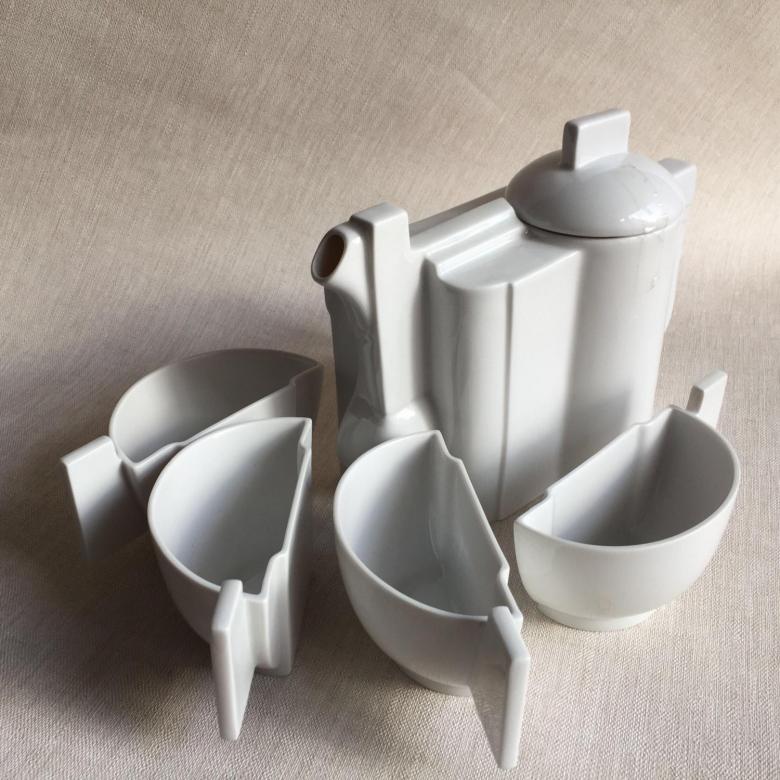





Lunar base "Star"

The first detailed project of the base on the moon. The concept of the lunar town was considered in the 1960s and 70s. It was planned to operate the station on the Moon solely for scientific purposes, although in fact the base also had military potential: it could accommodate missile systems and tracking equipment, inaccessible to terrestrial weapons. The program reached the final stage, but due to a number of problems, scientists had to curtail the project.
According to the project, the first “moon train” with 4 astronauts on board was to land on the moon. With the help of the train, the expedition members would conduct a detailed study of the area and begin to build a temporary lunar base. With the help of heavy rocket launchers, it was planned to deliver 9 modules to the lunar surface. Each module had a specific purpose: laboratory, storage, workshop, galley, dining room, medical center with a gym and three residential premises.
The length of the inhabited modules was 8.6 m, the diameter was 3.3 m; total mass - 18 tons. A shortened block of not more than 4 m in length was delivered to the moon on the spot. And then, thanks to a metal accordion, it stretched to the desired length. The interior was supposed to be filled with inflatable furniture, and residential cells were designed for two people.
Crews for lunar ships were selected, flights were planned for the late 1980s. What went wrong? Boosted rockets. The program was closed on November 24, 1972, when the fourth launch of the "lunar rocket" N-1 ended in an accident. According to analysts, the cause of the explosions was the inability to manage a large number of engines in a coordinated manner. This was the biggest failure of S.P. Queen. In addition, the designers estimated that about 50 billion rubles ($ 80 billion) would be required for lunar expeditions, the construction and settlement of the lunar base. It was too much. The idea of building a lunar base was postponed until later.
Visualization and Drawings 


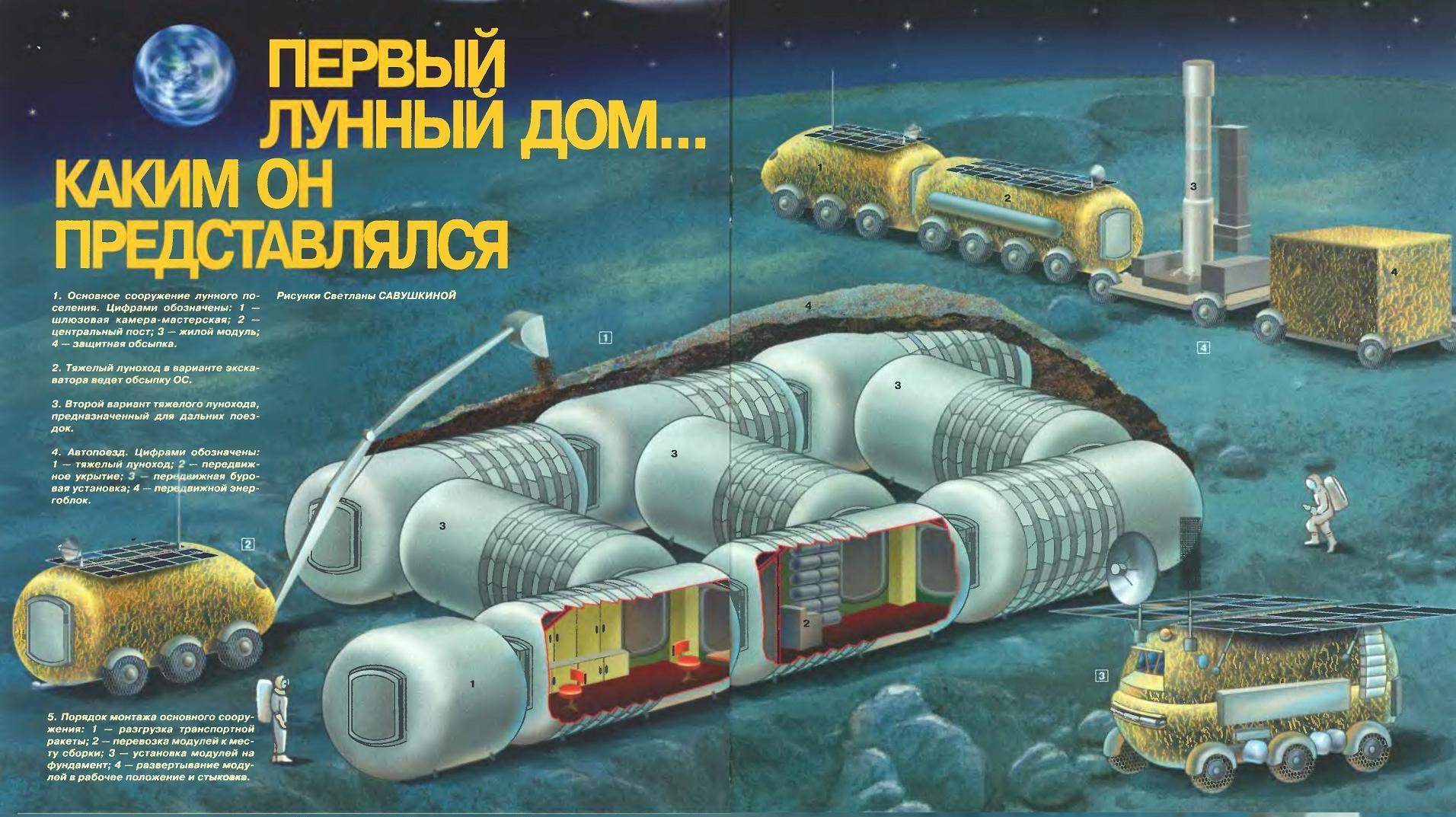




OS DEMOS

Around 1982-1983, at the Institute of Atomic Energy. I.V. Kurchatov brought distributions of the UNIX operating system (v6 and v7). Having connected specialists of other organizations to the work, scientists tried to adapt the OS to Soviet conditions: translate into Russian and establish compatibility with domestic equipment. First of all, with the SM-4 and SM-1420 machines. Localization was carried out by the Institute for Advanced Studies of the Minavtoprom.
After combining the teams, the project was called DEMOS (Dialogue Unified Mobile Operating System). It's funny that UNAS could also call it, as if contrasting the fact that UNIX is “with them”. And the Minavtoprom called the MNOS system (Machine Independent Operating System).
The Soviet OS actually combined the two versions of Unix: the 16-bit DEC PDP OS and the system for 32-bit VAX computers. DEMOS worked on both architectures. And when the production of SM 1700, the analogue of VAX 730, began at the plant in Vilnius, then the OS DEMOS was already installed on it.
In 1985, DEMOS 2.0 was released, and in 1988, the developers of the Soviet OS were awarded the Prize of the Council of Ministers of the USSR for Science and Technology. But in the 1990s, the project was closed. It's sad of course. After all, who knows, could our development surpass the
One more photo 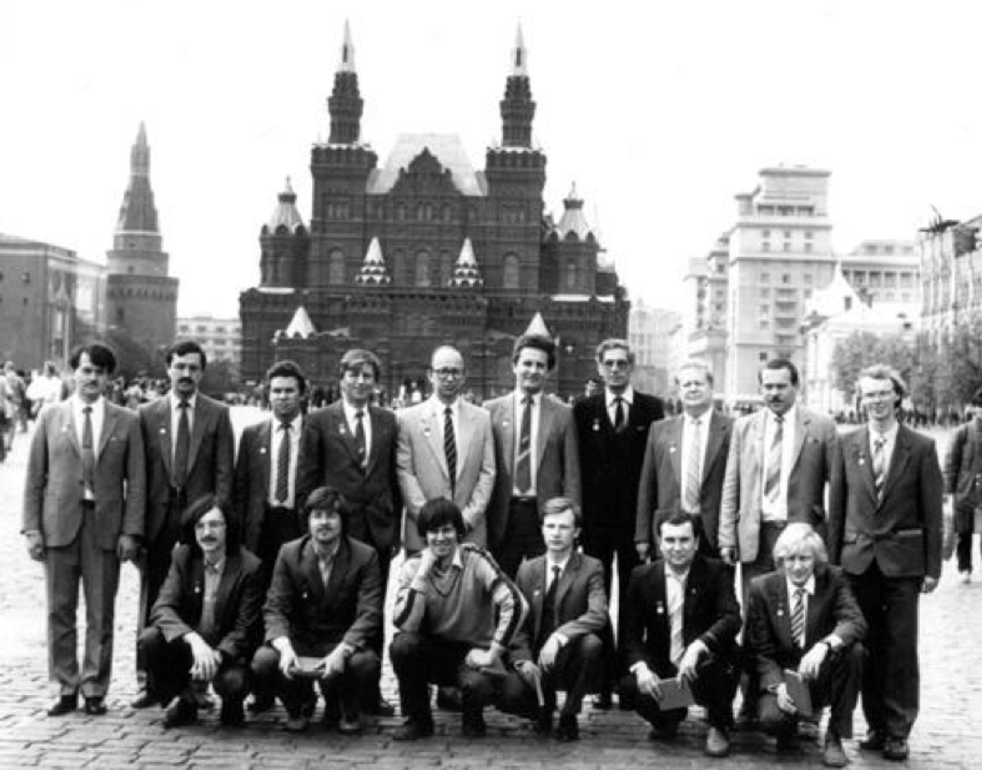
DEMOS developers after the award
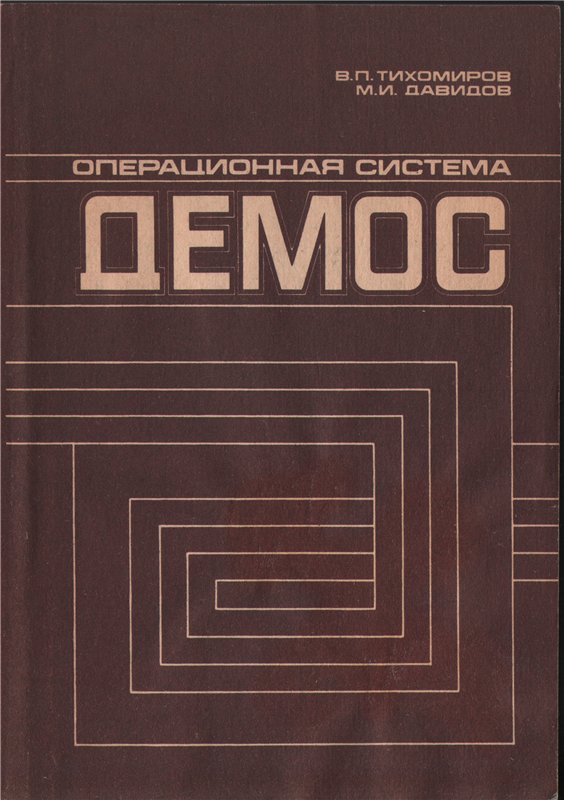
There was even a book on the Soviet OS. And you can still buy it!

Named after the OS created, the company survived the USSR

DEMOS developers after the award

There was even a book on the Soviet OS. And you can still buy it!

Named after the OS created, the company survived the USSR
Workspace Rodchenko

The constructivist interior of Alexander Rodchenko, dubbed the “Work Club”, was exhibited in the USSR Pavilion at the International Exhibition of Decorative Arts in Paris in 1925. This was the first major international exhibition in which the Soviet Union took part. Rodchenko created a multifunctional space that reflects the ideals of a new society looking to the future. It was believed that the interior would become the basic form of work clubs, both in design and planning decisions.
“Work Club” is not just a room decorated in a constructivist style. It was a real philosophy of creating a space in which Soviet workers could exchange opinions, make speeches, engage in self-education, play chess, etc. Following the canons of multifunctionality, the artist created compact objects that could transform into others.
For example, a folding stand could also be a place for lectures, speeches, theatrical evenings, and in order to save space, the chess table was made rotatable so that players could change the color of their figures without leaving their seats. According to Rodchenko, he was guided by the principle, "which makes it possible to deploy an object in his work over a large area, as well as compactly fold it at the end of the work."
Four colors were used in the design - gray, red, black and white. Coloring was given great importance - it emphasized the nature of objects and how to use them.
The project received a silver medal, and after the exhibition it was presented to the Communist Party of France, so it has never been exhibited in Russia. However, in 2008, German experts reconstructed the club for their exhibition “From Plane to Space. Malevich and early modernism, ”and then presented a copy of the Tretyakov Gallery.
Another photo of the office 





Underground boat

A dramatic story full of espionage passions and mysterious explosions. In the 1930s, engineer Alexander Trebelsky (according to other sources - Trebelev) literally raved about the idea of creating a "subterrine" - a vehicle that could move underground like tunnel shields, but at the same time faster, quieter and with greater benefit.
Initially, Trebelevsky tried to create a thermal supercontour - a device that, if necessary, could heat the outer shell of an underground boat and burn through solid soil. But later he abandoned this idea, inventing a design whose working principle was borrowed from an ordinary mole. These animals dig the ground, turning their paws and head, and then push their body with their hind legs. In this case, the earth is pushed into the walls of the resulting hole.
An underground boat was designed in the same way. A powerful drill was located on the nose, in the middle there were screws pushing the rock into the walls of the wells, and behind were four powerful jacks that moved the device forward. When the drill rotated at a speed of 300 rpm, the submarine overcame a distance of 10 m in an hour. It seemed to be a success. It turned out that seemed.
In 1933, Trebelevsky was arrested by the NKVD for meeting with a certain engineer during a trip to Germany and bringing in blueprints from there. It turned out that Trebelevsky borrowed the idea of an underground boat from Horner von Wern and tried to bring it to mind. Drawings settled somewhere in the NKVD. Like the engineer himself.
The iron mole was recalled again in the 60s: Nikita Khrushchev publicly promised "to get the imperialists not only in space but also underground." The advanced minds of the USSR were connected to work on the new boat: Leningrad professor Babaev and even academician Sakharov. The result of painstaking work was a machine with a nuclear reactor, managed by a crew of 5 crew members and capable of transporting a ton of explosives and 15 fighters. They tested the subterrine in the fall of 1964 in the Urals near Mount Grace. The underground boat was called the “Battle Mole”.
The device penetrated the ground at the speed of a pedestrian, walked about 15 km and destroyed the enemy’s conditional underground bunker. The test results surprised the military and scientists. They decided to repeat the experiment, but the battle mole exploded underground, destroying all the people on board and being permanently stuck in the bowels of the Ural mountains. What caused the explosion is not known for certain, because all the materials on this incident are still under the heading "top secret." Most likely, the plant’s nuclear engine exploded. After the emergency, the decision on the further use of the underground boat was postponed, and then completely turned off.
One more photo 
What could a subterrin look like?
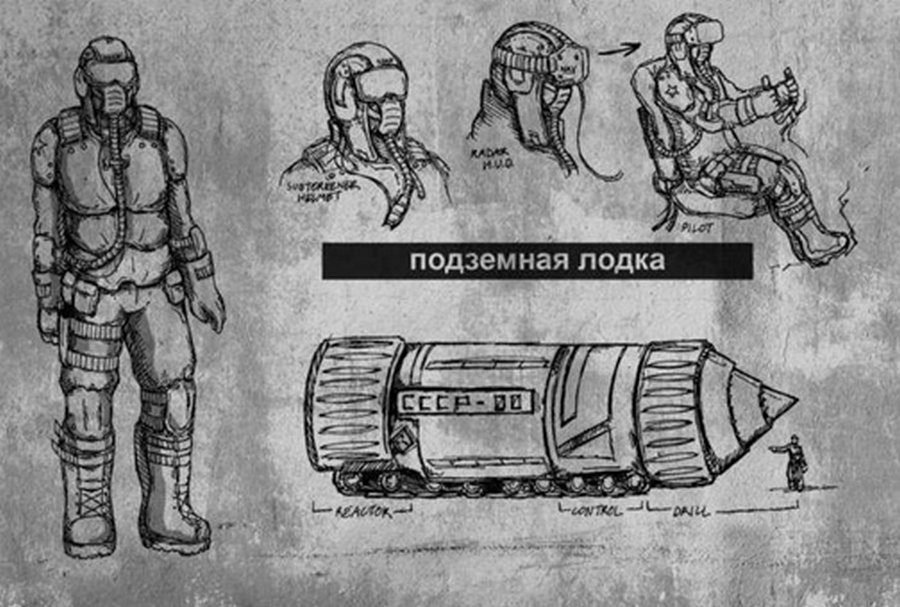
Crew outfit
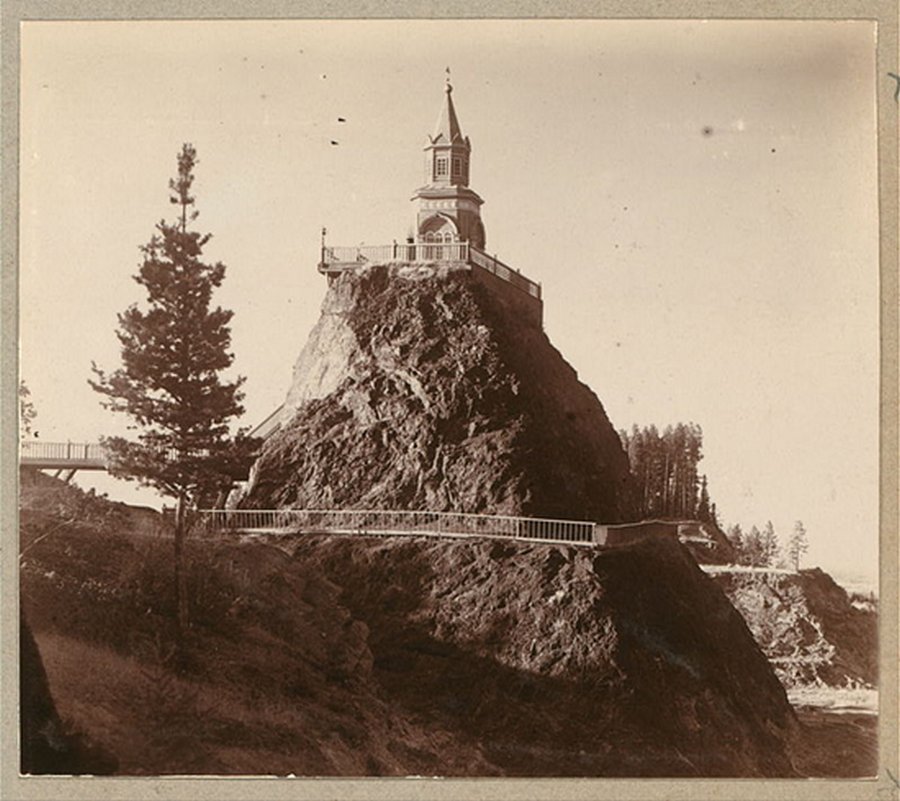
The same mountain where the tests took place

What could a subterrin look like?

Crew outfit

The same mountain where the tests took place
And what interesting, but not “soaring” projects do you remember?
What else is useful to read on the Cloud4Y blog
→ vGPU - use cannot be ignored
→ AI helps study animals in Africa
→ 4 ways to save on backups in the cloud
→ 5 Best Kubernetes Distributions
→ Robots and strawberries: how AI increases field yields
Subscribe to our Telegram channel so as not to miss another article! We write no more than twice a week and only on business.
All Articles